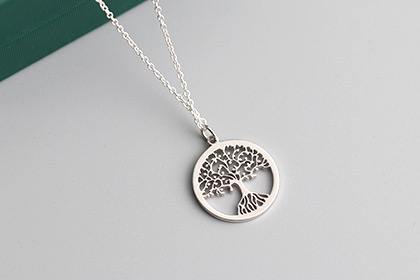Is your Sterling Silver Jewelry becoming tarnished? Is your Silver ring leaving a green or black mark on your finger? If you do get a green or black blemish on your skin from your silver jewelry, don't panic - it is not toxic to your skin and is easy to wipe off. Just because your silver ring leaves a dark mark on your finger does not mean that the ring is of low-quality silver. Below, we explain why sterling silver tarnishes. We also give you some simple steps to help resolve the problem.
Common Reasons why Sterling Silver turns green or black.
Silver jewelry reacts with hydrogen sulfide (sulfur), which is present in the air. This chemical reaction causes the jewelry to tarnish over time, which turns it black or green. The following factors worsen or speed up tarnishing.
- Moisture and Humidity: Moisture in the air and on your skin can tarnish your silver jewelry. This is most common in hot and humid environments.
- Cosmetics: Beauty products such as hair spray, body lotion, perfume, and makeup may contain chemicals that react with silver causing it to tarnish. If these cosmetics are on the skin or clothing, they can rub off the silver jewelry and cause discoloration.
- Cleaning detergents: Many cleaning products contain harsh chemicals that tarnish silver jewelry.
- Natural Oils: Natural oils produced by the skin can also react with silver jewelry. Your skin's acidity affects silver - the more acidic your skin is, the faster the silver jewelry will tarnish.
- Sulfur: Sulfur reacts with silver and causes tarnishing. High levels of sulfur can be found in coal and oil and foods such as fish, eggs, and onions.
How to prevent Sterling Silver from Tarnishing.
Follow these simple steps to keep your silver jewelry glistening!
- Cleaning. Use a soft, dry cloth or silver polishing cloth to clean your silver jewelry regularly. This will help to keep it shiny.
- Dry. Keep your silver jewelry dry. Do not store it in a damp or humid room such as the bathroom.
- Storage. Store your silver jewelry in a cool, dry, airtight container. If possible, store each piece individually to avoid scratches. Small ziplock bags are a good idea for storage.
- Cosmetics. Remove silver rings and jewelry while applying cosmetics such as makeup, hairspray, and perfume. Clean and dry the areas of your skin that will be in contact with the jewelry.
- Detergents. Do not wear silver jewelry when using cleaning detergents, as the harsh chemicals in cleaning products may cause tarnishing.
- Exercise. If doing intensive exercise, take off your silver jewelry to avoid tarnishing caused by excessive sweat.
- Swimming. Remove silver jewelry before going to the swimming pool, gym, or spa. The chlorine in swimming pools will tarnish the silver and leave a dark mark on your skin.
- Clear Nail Polish. You can apply a coat of nail polish to the inside of your silver rings. This layer of nail polish creates a barrier between your skin and the silver and will help prevent tarnishing. You will need to recoat the ring over time, as the nail polish will gradually wear off.
- Abrasive Chemicals. In general, remove your silver rings when doing anything involving harsh chemicals, intense heat, bright sunlight, water, and sweat.
Do I have an allergy to silver?
In rare cases, people can have a skin allergy to silver jewelry, resulting in symptoms such as swelling, rashes, or pain. Metals such as nickel, copper, and chromium are usually the cause of these allergic reactions. These metals are often added to sterling silver to make the product more durable and robust. If you are allergic to nickel or copper, always check what metals are used in the piece of jewelry you are planning to buy. You can also use alternative nickel-free or copper-free jewelry such as titanium, platinum, and 18K gold.
To sum up, remember to keep your silver jewelry dry and clean it regularly. With a little care and attention, you can ensure that your silver jewelry always sparkles and shines!


